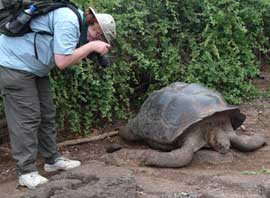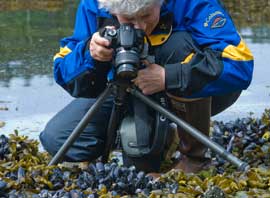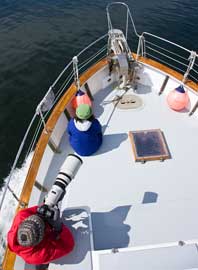General Photography Tips

What to Bring
- Several sets of spare batteries (you can charge them on the boat)
- Lots of extra memory cards
- External hard drive or thumb drives
- Waterproof carry bag
- Ziplocks for camera and/or garbage bags for camera bag or backpack
For Casual Photographers
- Point-and-shoot digital and 35-mm (recent ones are great!)
- Don't forget extra memory, batteries, a waterproof bag, and all equipment manuals
For Avid Photographers
Cameras:
- Medium format or 35 mm single-lens reflex are the most versatile
- Consider a second camera body so you can quickly shoot with different lenses. A spare also provides a valuable backup. “An immediate insurance policy!”
Lenses:
- The most useful lens is a zoom of about 28-105 mm
- Consider another in the 70-400 range
- Lenses longer than 400 mm will only be useful on land
Equipment:
- Lens tissues
- Tripod
- Polarizing filters to cut glare
- Graduated neutral-density filters are good for some landscapes
Digital Camera Suggestions
(courtesy of Betty Sederquist)
 Our Alaska trips are well-suited to those with digital camera equipment. With digital equipment you can take full advantage of the many spectacular photo opportunities we offer and shoot prolifically without worrying about the cost of film and processing. The Delphinus provides a safe, warm, dry home for your gear. AC power is available for recharging equipment; we have lots of power strips on board and each cabin also has AC power (although it's not available at night). What to bring? First, your digital camera should be of decent quality, capable of 6.0 megapixel size files or larger so you can make decent-quality enlargements later. If you don't have a digital camera yet, wait until a couple of months before the trip, as prices steadily fall on anything to do with digital cameras and computers. That lead time will allow you to familiarize yourself with the camera and work out any bugs.
Our Alaska trips are well-suited to those with digital camera equipment. With digital equipment you can take full advantage of the many spectacular photo opportunities we offer and shoot prolifically without worrying about the cost of film and processing. The Delphinus provides a safe, warm, dry home for your gear. AC power is available for recharging equipment; we have lots of power strips on board and each cabin also has AC power (although it's not available at night). What to bring? First, your digital camera should be of decent quality, capable of 6.0 megapixel size files or larger so you can make decent-quality enlargements later. If you don't have a digital camera yet, wait until a couple of months before the trip, as prices steadily fall on anything to do with digital cameras and computers. That lead time will allow you to familiarize yourself with the camera and work out any bugs.
The most useful lens is a 28-105mm zoom. You should also consider one in the 70-300mm range. Lenses longer than 300mm are only useful on land. You may want a wider-angle lens for landscapes and so consider the 80-400mm or 100-400mm range. Unless you have a digital camera body that handles high ISO settings with a minimal loss of quality, lenses longer than 400mm can be problematic-with camera movement causing loss of sharpness in low light light conditions when shooting from a moving boat. Some newer lenses and camera bodies feature image stabilization, a definite plus for wildlife photography.
Recent generations of digital camera SLRs handle high ISO numbers astonishingly well, which translates to being able to photograph in the low-light conditions often found in Southeast Alaska and still retain high shutter speeds essential for quality wildlife photography, for example. However, quality is a subjective thing, and we urge you to do a lot of testing at different ISOs with your camera BEFORE the trip to settle upon what standards you're okay with. In general, plain shadow areas are more apt to show "digital noise." Textured fur, vegetation and so forth are less of a problem. On the trips themselves, great photo ops often happen so fast that you won't have time for leisured testing.
Bring enough media cards for your camera to get you through a day of shooting. If you shoot camera RAW format you'll find that you go through your cards astonishingly quickly. Prices on these cards drop steadily. You'll also need to transfer your images from your cards to some kind of hard drive at the end of the day. Several manufacturers make small portable drives just for this purpose; these drives can store thousands of images. For greater flexibility, you may want to bring a laptop computer for high-quality review of your work while you're on board. (And if you're in the market for a laptop, consider one that's lightweight, as it's literally a drag to haul any extra weight.) Don't forget all necessary cables and chargers! Bring lots of batteries!
The weather is often damp and the humidity high in coastal Alaska. Many digital cameras are susceptible to damp conditions. Make every effort to keep your gear dry, with quality gear bags, plastic baggies or Zip Locks, and maybe a small rag or chamois cloth for wiping down your equipment should it get wet. There are also many high-end, more elegant options for keeping your gear dry. You may want to bring a backup camera body-digital or film-in case of equipment problems.
Equipment Ideas from Brenda Tharp
 These are ideas, suggestions, etc. You need to pack what works for YOU and your style of photography. Keeping it light but complete will make for easier travel, though, and storage on the boat.
These are ideas, suggestions, etc. You need to pack what works for YOU and your style of photography. Keeping it light but complete will make for easier travel, though, and storage on the boat.
- Two Camera Bodies (one as spare or to have a short telephoto mounted while using the longer lens on the other)
- Wide angle, medium telephoto and long telephoto lenses. We’ll have opportunities for the whole range on this trip! If you have a 300mm or longer, bring it. On the boat, we often get to use the 70-300mm range as the whales get close to us; but longer lenses means you can photograph things a little further out, too, and those will also be good for bear photography.
- Macro lens or macro accessories - such as a diopter for your 70-300mm range lens, extension tubes. We will have the opportunity for macro photography on some of our shore excursions, potentially. But if you have to minimize gear because of those longer lenses, I’d suggest the diopter for use on the medium telephoto instead of the weight/bulk of a macro. Your choice!
- Remote shutter release
- Sturdy tripod to support the heaviest camera/lens combination you have.
- Rain gear for the camera
(We will see some rain, no doubt - it is Alaska, after all!) There are several that are functional. Optech’s Rainsleeves are inexpensive, clear and allow you to shoot without looking through the plastic; I’m not sure if they make them for shorter lenses, I used them for 100-400mm lenses in Alaska and they were great. Storm Jackets are also simple, and functional. They don’t cover the back entirely, but do protect the camera/lens while shooting in the rain. They come in three sizes, the specs on on their site (www.stormjackets.com) Another more expensive option is Kata products’ rain protectors. They’re a little more bulky and yet they do protect the camera very well - and might work better on a tripod than hand-held. FM Photography’s Shutterhat (www.visibledust.com ) produces the Artic Butterfly which is very good at picking up stubborn dust off sensors, too. It runs on AAA batteries and will help you keep your sensor cleaner on the trip. Visit www.visibledust.com for info and to purchase. We’ll have ours with us but the brush is specific to sensor size/chamber space. - Your instruction manual for the camera.
- A gardener’s kneeling pad - or something soft like a square of closed-cell foam, to sit on while we’re on shore waiting/watching for bears (Optional but worth having)
Interested in Photography?
All of Dolphin Charters' trips provide inspiring photographic opportunities. If you're interested in combining an adventure trip with a nature-photo tour, consider a trip led by one of our professional photographers.

